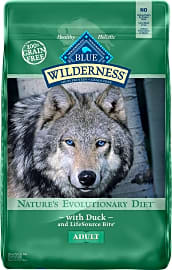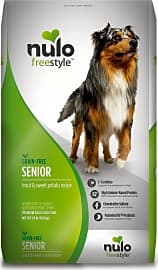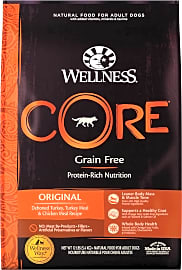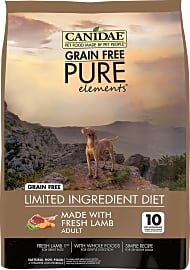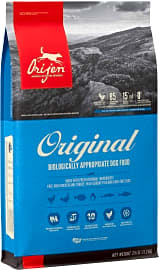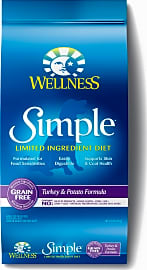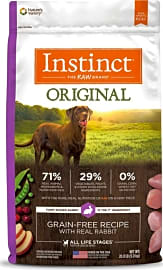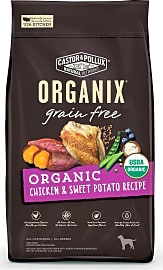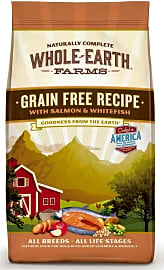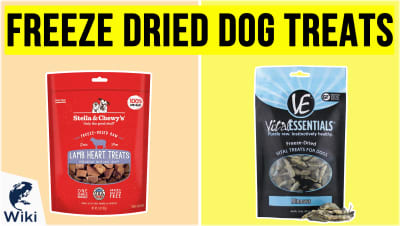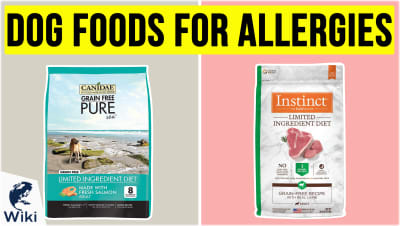The 10 Best Grain-Free Dog Foods

This wiki has been updated 39 times since it was first published in March of 2016. If your dogs have allergies, skin problems, or sensitive stomachs, then you may want to try one of these easy-to-digest, grain-free dog foods, which are designed to provide a more natural diet closer to what they would eat in the wild to boost their overall health. They offer wholesome ingredients in a variety of flavors and come in at price points to suit any pooch and his or her owner. When users buy our independently chosen editorial recommendations, we may earn commissions to help fund the Wiki.
Editor's Notes
April 13, 2020:
We feel that anyone looking to feed their pooch grain-free dog food isn't just concerned about not giving their dog grain, but also wants something that includes a high-quality blend of ingredients, even if that means spending a bit more money. With that in mind, we carefully analyzed what was put into every food on this list to ensure they not only provide a balanced diet, but also offer extra health benefits, such as being high in antioxidants and omega fatty acids.
Of course, no matter how healthy a dog food is, it won't do your four-legged family member any good if they refuse to eat it, which is why we decided to eliminate Honest Kitchen Human Grade. Though we liked the ingredient list, there were simply too many reports of dogs not wanting to eat it. AvoDerm Natural suffered from similar complaints, so it too was removed.
Another food that lost its spot on our list was Merrick Dry. Unlike the above two though, we don't have any real complaints against it and still believe it is a good choice for many dogs, especially those that need a lot of protein. We just felt there were better options more deserving of a place, such as Orijen Original, which uses all free-range or wild-caught meat and fish, and which also boasts 38 percent minimum protein. Instinct Original Rabbit is another option that is very high in protein, and which boasts very high-quality protein sources. Since it eschews the use of traditional meat sources, like chicken or beef, and instead relies on rabbit and various Pacific fish, it can be a very good option for dogs with food sensitivities.
While on the topic of dogs with food allergies, we have also included Canidae Pure Elements and Wellness Simple Turkey And Potato, which both have limited ingredient lists, making them ideal for those pooches who are sensitive to a lot of different foods.
People often mistakenly believe that older dogs need a food with less protein, but the opposite is actually true. What they really need is a high protein food that is relatively low in fat, which can be hard to find. Luckily, we have identified Nulo Senior Trout And Potato, which has 30 percent protein with just 12 percent fat, so it can help those aging pups retain their muscle mass while keeping a healthy weight.
Just like people, animals generally do well when their diet includes a wide range of ingredients, since this will offer them a more balanced variety of supplements, minerals, and vitamins. That, combined with the prebiotic blend and high number of superfoods in Taste of the Wild High Prairie is what allowed it to rank very highly and makes it one of our top recommendations.
If you are putting the effort into providing your furry friend with the best quality food you can find, it only stands to reason that you should also strive to get them healthiest treats, whether for training or simple snacking purposes. To save you time, we have also put together lists of the best healthy dog treats and freeze-dried dog treats.
Special Honors
American Journey Salmon & Sweet Potato While we wouldn't rate American Journey Salmon & Sweet Potato as one of the best grain-free dog foods, we do think it is a decent choice for someone looking to feed their pooch a high-quality choice that is limited by a tight budget. It is more affordable than most other options and doesn't contain any animal byproducts, however, some may not like the addition of dried beet pulp, which is a controversial ingredient. chewy.com
Pet MD Principles of Dog Nutrition While we have put together this list to help you save time when trying to find the best grain-free dog food for your canine, we feel it is important that people understand the nutritional needs of their pets, which is why we recommend Principles of Dog Nutrition as required reading for every pet owner. It covers things like the digestibility of various ingredients, how to understand the guaranteed analysis on the label of foods, how much to feed dogs at various stages in their life, and other useful information. petmd.com
Keeping Your Furry Companion Healthy
However, some amount of grain can also be beneficial to a dog's balanced diet, so eliminating them entirely is not always the right answer either.
If you've ever owned a dog or a cat, you can attest to the understanding that, like humans, animals have a soul, an identity, and you couldn't imagine living life without them as a part of your family. It stands to reason that a dog parent only wants what's best for their furry companion to ensure a long, healthy life. This consideration includes finding the right dog food, especially if your pet is prone to allergies or stomach sensitivities. In this respect, considering a grain-free kibble can be an excellent route to providing superior nutrition and a balanced diet to your pooch.
Though dogs (like many other animals) have become anthropomorphized by humans, the anatomy of their digestive systems has not deviated all that much from those of their ancestral carnivores. In the wild, wolves don't consume heavily-processed ingredients. Instead, their diets consist of natural, raw, and protein-rich foods, so it stands to reason that maintaining a similar type of diet for a doggy descendant would be a great place to start. This is not to say that a grain-free diet is the right move in every situation or with every breed, but foods rich in proteins, vegetables, fruits, and vitamins, and without unnecessary fillers, are certainly the way to a healthy digestive tract for your pooch. Many grain-free formulas contain nearly all of these active ingredients.
If you're wondering whether there are dangers to the use of excessive amounts of grains and wheat in your dog's diet, the answer is yes in some cases. To explain, consider a dog's lupine brethren once again. Both wolves and dogs have minimal natural digestive support for breaking down and metabolizing things like complex carbohydrates and cereal grains, particularly since the wolf diet consists primarily of naturally-found proteins low in carbohydrates. By contrast, complex fibers and grains either remain undigested or they're difficult to digest, meaning Fido's body is relying more on fermentation to break those ingredients down, which can lead to dangerous gastric issues.
Over time, consumption of these grains can cause damage to the lining of a dog's digestive tract, leading to bowel inflammation disorders or food sensitivities and allergies that were not previously present. However, some amount of grain can also be beneficial to a dog's balanced diet, so eliminating them entirely is not always the right answer either. Using discretion and consulting with one's veterinarian can be a valuable resource to determining the best diet for a new canine family member. Typically, complex carbs make up approximately 10% of a dog's diet.
Grain-free foods provide a wide variety of benefits to a dog, especially the moist and freeze-dried varieties if a dry kibble isn't always available. Other than aiding in easy digestion, grain-free foods keep dogs feeling satisfied for longer periods of time, and this is not due to the use of unhealthy filler materials, but rather from the richness of the proteins involved. These types of foods also deliver additional energy to your dog. Grain-free foods often result in smaller stools and less waste, as more of the nutrients are being absorbed by the body and utilized.
How To Find The Right Food
Regardless of what you decide to feed your pooch, balance is the most important thing to consider above all else. Keep in mind that you don't have to go crazy over grain-free diets. Though beneficial and though we've discussed conventional theories about dogs and their ancestors, there is no single prescribed diet for every breed. Different dogs can metabolize foods in their own unique ways, so it may take some trial and error to determine what works best for your pet.
Different dogs can metabolize foods in their own unique ways, so it may take some trial and error to determine what works best for your pet.
Some dogs can benefit from additional simple carbs in their grain-free kibble formula. Just as an example, I feed my standard poodles a grain-free base formula with roasted bison, venison, and sweet potato. My dogs absolutely adore sweet potatoes. In fact, we go so far as to bake sweet potatoes fresh in the oven and mix the contents in with the rest of their kibble at dinnertime. They seem to enjoy it and digest it easily. For extra flavor along with the grain-free kibble, consider adding a bit of Greek yogurt into the mix as well. It's a great source of protein and probiotics, but be sure to use it in moderation, as it's still considered dairy and may not agree with all canine stomachs.
Secondly, one must carefully check the list of ingredients in their food of choice. Make sure that superfluous filler ingredients don't constitute the majority of the formula and that it's made up of a balanced mixture of whole fruits, vegetables, and proteins.
Next, if your dog hasn't previously been on a grain-free diet, do not transfer the animal cold turkey, as that could be a shock to their digestive system. Instead, introduce the new food into your dog's diet slowly over the course of several days to a couple of weeks to ensure they like it, that they're used to the taste, and that they're not suffering from any stool issues.
Finally, make use of your veterinarian as a resource when you're not sure which type or brand of food you're thinking of trying. The vet office can be a wealth of good, breed-specific information with regard to diets.
A Brief History Of Grain-Free Dog Food
Canis familiaris, also known as our companion dog species that we've come to know and love today, evolved alongside humans as far back as thirty thousand years. As humans developed from a hunter-gatherer societies into stable towns and villages, our eating habits also changed, as did those of our pets, particularly considering we've learned how to store foods for longer periods of time.
Commercially-available pet food really took hold during the 1950s, first in the form of canned food followed by dry pellets sprayed with synthetic nutrients.
Prior to the advent of conventional dog foods, most dogs lived on diets that included grains, meats, table scraps and homemade food from their owners. This started to change by the mid-nineteenth century with the first specifically-tailored foods for dogs, credited to American electrician, James Spratt. During his time living in London, Spratt observed dogs living around a local shipyard and feeding off scraps of discarded biscuits, sparking his design for the first dog treat. He then developed his own dog food consisting of a combination of wheat meals, vegetables and meat.
It wasn't until the 1900's that the idea of pet food became more popular in the form of canned horse meat, introduced in the United States after World War One as a means to dispose of deceased horses. By the end of World War Two, pet food represented a new opportunity to market by-products as a profitable source of income.
Commercially-available pet food really took hold during the 1950s, first in the form of canned food followed by dry pellets sprayed with synthetic nutrients. The 1960's and 1970's saw a diversification in flavors of available dog foods as well as the refinement of the extrusion process. Following the 2006-2007 pet food recall, raw food and grain-free diets became much more popular than ever before. Today, there is an overwhelming variety of grain-free kibbles and wet foods to suit most any breed.


